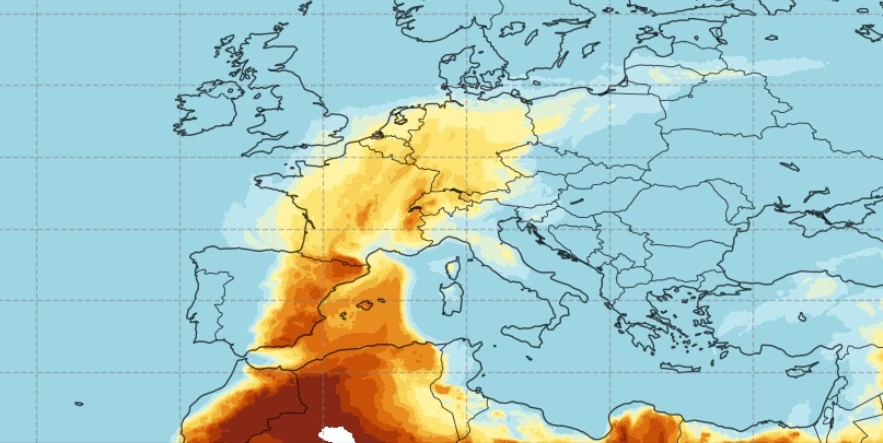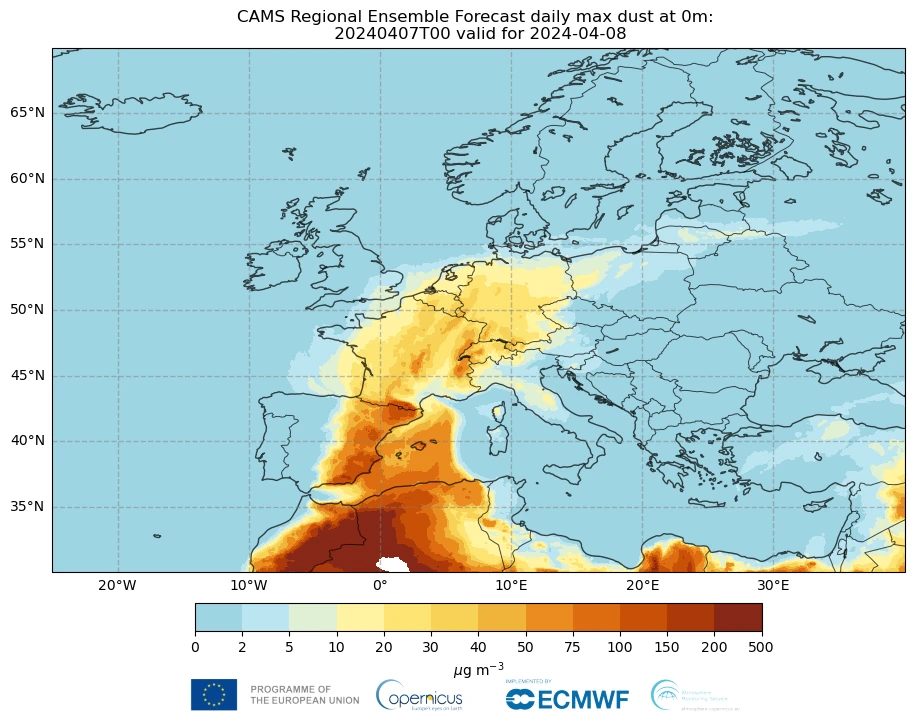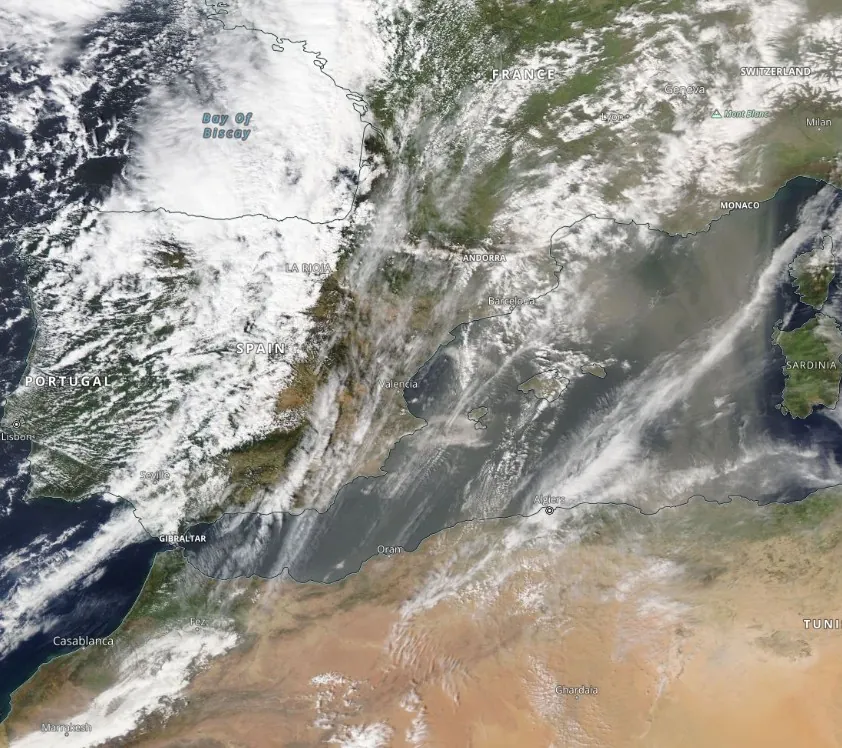Exceptionally intense Saharan dust episode over Europe degrading air quality, suggesting changes in atmospheric circulation patterns

A third exceptionally large wave of Saharan dust in just two weeks is moving over parts of Europe, significantly increasing PM10 concentrations at ground level for the Iberian Peninsula, and some parts of France and Germany. This event coincides with high birch pollen concentrations, potentially affecting sensitive persons.
- While it is not unusual for Saharan dust plumes to reach Europe, there has been an increase in the intensity and frequency of such episodes in recent years, which could be potentially attributed to changes in atmospheric circulation patterns.
This latest Saharan dust event started on April 6, with the Copernicus Atmosphere Monitoring Service (CAMS) forecasts showing that particulate matter concentrations (PM10) in several parts of Europe will increase due to the incoming dust. The dust plume has been traveling across most of the Iberian Peninsula to reach southeastern France, Germany, and Scandinavia.
According to CAMS Earth observers, daily maximum values of CAMS PM10 forecasts have been showing significant concentrations at surface level, and exceeding the EU 24-hour mean exposure threshold of 50 µg/m3 in some of the affected regions. As a result of this episode, there has been a degradation of the air quality in several countries. “Moreover, hazy skies and deposits on surfaces including cars and windows can be attributed to this episode,” CAMS’ Nuria Lopez notes.
Specifically, this event significantly degraded air quality in parts of south and eastern Spain, with some stations from the Spanish weather service Aemet recording PM10 concentrations over 200µg/m3, well above the 50µg/m3 considered healthy.
Extreme dust levels were present in southeastern Spanish cities such as Almería, Granada, Málaga, Cartagena, and others, but the spike was also noticeable, to a lesser extent, in other European cities such as Geneva in Switzerland, Clermont-Ferrand in France and Bonn, Germany.

“This latest Saharan dust episode is the third of its kind in the last two weeks, and is related to the weather pattern that led to warmer weather across western Europe in recent days,” Mark Parrington, Senior Scientist at the Copernicus Atmosphere Monitoring Service, said.
“The two previous episodes were mainly over the Mediterranean and southern Europe, although some effects such as deposition on people’s cars occurred as far north as Scandinavia last weekend. While it is not unusual for Saharan dust plumes to reach Europe, there has been an increase in the intensity and frequency of such episodes in recent years, which could be potentially attributed to changes in atmospheric circulation patterns.”
This event coincides with high birch pollen concentrations, potentially affecting sensitive persons. Therefore, CAMS experts are urging people in affected regions to stay informed with their local air quality authority.

In February 2024, CAMS reported a relatively high number of intense Saharan dust transport episodes observed during winter and continuing into spring, with the Iberian Peninsula, southern France, and Italy the most affected.
“The observed trend is consistent with a recent research in which a team of Spanish scientists pointed to a sharp increase of Saharan dust intrusions in Europe during the winters 2020-2022, associated with changes in atmospheric circulation,” CAMS scientists said.
From the abstract:
“During the winters of the 2020–2022 period, several intense North African dust intrusions affected Europe. Some of them displayed a duration never recorded before. They were referred to as exceptional by several international operational and research institutions considering that wintertime is the season with minimum dust activity in the Mediterranean and Europe… The main objective of the present work is to analyze the atmospheric drivers (synoptic and large-scale environments) of wintertime (from January to March) dust events over the region covering North Africa, the Western Mediterranean and the Euro-Atlantic during the period 2003–2022.
Overall, our results indicate large interannual variability over the study period. A dust catalogue of dust events identified by aerosols retrievals from satellite and aerosol reanalysis products shows a very irregular record and large differences between winter months. The analyses demonstrate a positive anomaly in dust concentration and maximum altitude during the dust events of 2020–2022 in comparison with those of previous years (2003–2019).
Winter dust events over western Mediterranean are associated with enhanced blocking activity over the Euro-Atlantic sector, which favours the obstruction of the westerlies and the occurrence of cut-off lows at subtropical latitudes. However, these high-pressure systems can exhibit a large variety of configurations, including meridional dipole blocking patterns with poleward shifted jets or Mediterranean subtropical ridges with an intensified mid-latitude jet. The former was more frequent during the reference 2003–2019 period, whereas the latter was relatively common during the anomalous 2020–2022 period.”
References:
1 New, exceptionally intense, Saharan dust episode through western Europe – Copernicus EU/CAMS – April 8, 2024
2 Sharp increase of Saharan dust intrusions over the Western Mediterranean and Euro-Atlantic region in winters 2020–2022 and associated atmospheric circulation – EGU (preprint) 2023 – Emilio Cuevas-Agulló, David Barriopedro, Rosa Delia García, Silvia Alonso-Pérez, Juan Jesús González-Alemán, Ernest Werner, David Suárez, Juan José Bustos, Gerardo García-Castrillo, Omaira García, África Barreto, and Sara Basart – EGU Atmos. Chem. Phys. – 24, 4083–4104 – https://doi.org/10.5194/acp-24-4083-2024,
Featured image credit: Copernicus EU/CAMS

The changes in atmospheric circulation patterns have been obvious for many years, and that has to do with the rapid changes in Earth’s magnetic field. But, of course the advocates of the pseudoscience theory of man-made climate change are blaming the changes on the CO₂ emissions